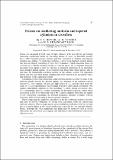Forces on oscillating uniform and tapered cylinders in a crossflow
Author(s)
Hover, F. S.; Techet, A. H.; Triantafyllou, M.S.
DownloadTriantafyllou_1998_Forces.pdf (984.1Kb)
Terms of use
Metadata
Show full item recordAbstract
Forces are measured at both ends of rigid cylinders with span 60 cm, performing
transverse oscillations within an oncoming stream of water, at Reynolds number
Re ~3800. Forced harmonic motions and free vibrations of uniform and tapered
cylinders are studied. To study free motions, a novel force-feedback control system
has been developed, consisting of: (a) a force transducer, which measures forces on
a section of a cylinder moving forward at constant speed; (b) a computer using the
measured force signal to drive in real time a numerical simulation of an equivalent
mass-dashpot-spring system; (c) a servomotor and linear table which impose, also in
real time, the numerically calculated motion on the cylinder section. The apparatus
allows very low equivalent system damping and strict control of the parametric values
and structure of the equivalent system.
Calculation of the cross-correlation coefficient between forces at the two ends of the uniform cylinder reveals five distinct regimes as a function of the nominal reduced
velocity Vrn: two regimes, for low and high values of Vrn, and far away from the
value of VrS corresponding to the Strouhal frequency, show small correlation; two
regimes immediately adjacent to, but excluding, VrS show strong correlation, close
to 1; surprisingly, there is a regime containing the Strouhal frequency, within which correlation is low. Free vibrations with a 40:1 tapered cylinder show that the regime of low correlation, containing the Strouhal frequency, stretches to higher reduced velocities, while lock-in starts at lower reduced velocities.
When comparing the amplitude and phase of the lift coefficient measured for free
and then for forced vibrations, we obtain close agreement, both for tapered and
uniform cylinders. When comparing the cross-correlation coefficient however, we find that it is much higher in the forced oscillations, especially for the uniform cylinder. Hence, although the force magnitude and phase may be replicated well in forced
vibrations, the correlation data suggest that differences exist between free and forced
vibration cases.
Date issued
1998Department
Massachusetts Institute of Technology. Department of Mechanical EngineeringPublisher
Cambridge University Press
Citation
Journal of Fluid Mechanics, 363, p.97-114 (1998)
Keywords
crossflow, Reynolds number